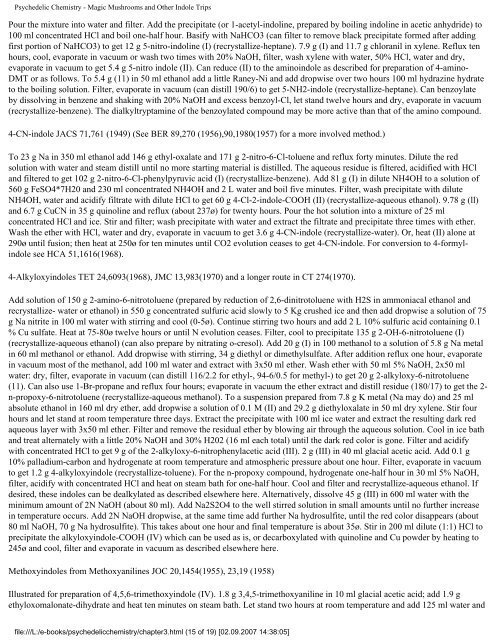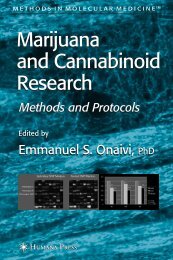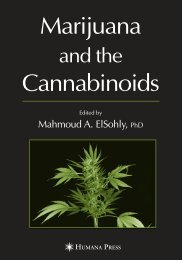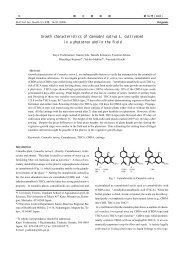Psychedelic Chemistry - Hampapartiet
Psychedelic Chemistry - Hampapartiet
Psychedelic Chemistry - Hampapartiet
- No tags were found...
You also want an ePaper? Increase the reach of your titles
YUMPU automatically turns print PDFs into web optimized ePapers that Google loves.
<strong>Psychedelic</strong> <strong>Chemistry</strong> - Magic Mushrooms and Other Indole TripsPour the mixture into water and filter. Add the precipitate (or 1-acetyl-indoline, prepared by boiling indoline in acetic anhydride) to100 ml concentrated HCl and boil one-half hour. Basify with NaHCO3 (can filter to remove black precipitate formed after addingfirst portion of NaHCO3) to get 12 g 5-nitro-indoline (I) (recrystallize-heptane). 7.9 g (I) and 11.7 g chloranil in xylene. Reflux tenhours, cool, evaporate in vacuum or wash two times with 20% NaOH, filter, wash xylene with water, 50% HCl, water and dry,evaporate in vacuum to get 5.4 g 5-nitro indole (II). Can reduce (II) to the aminoindole as described for preparation of 4-amino-DMT or as follows. To 5.4 g (11) in 50 ml ethanol add a little Raney-Ni and add dropwise over two hours 100 ml hydrazine hydrateto the boiling solution. Filter, evaporate in vacuum (can distill 190/6) to get 5-NH2-indole (recrystallize-heptane). Can benzoylateby dissolving in benzene and shaking with 20% NaOH and excess benzoyl-Cl, let stand twelve hours and dry, evaporate in vacuum(recrystallize-benzene). The dialkyltryptamine of the benzoylated compound may be more active than that of the amino compound.4-CN-indole JACS 71,761 (1949) (See BER 89,270 (1956),90,1980(1957) for a more involved method.)To 23 g Na in 350 ml ethanol add 146 g ethyl-oxalate and 171 g 2-nitro-6-Cl-toluene and reflux forty minutes. Dilute the redsolution with water and steam distill until no more starting material is distilled. The aqueous residue is filtered, acidified with HCland filtered to get 102 g 2-nitro-6-Cl-phenylpyruvic acid (I) (recrystallize-benzene). Add 81 g (I) in dilute NH4OH to a solution of560 g FeSO4*7H20 and 230 ml concentrated NH4OH and 2 L water and boil five minutes. Filter, wash precipitate with diluteNH4OH, water and acidify filtrate with dilute HCl to get 60 g 4-Cl-2-indole-COOH (II) (recrystallize-aqueous ethanol). 9.78 g (ll)and 6.7 g CuCN in 35 g quinoline and reflux (about 237ø) for twenty hours. Pour the hot solution into a mixture of 25 mlconcentrated HCl and ice. Stir and filter; wash precipitate with water and extract the filtrate and precipitate three times with ether.Wash the ether with HCl, water and dry, evaporate in vacuum to get 3.6 g 4-CN-indole (recrystallize-water). Or, heat (II) alone at290ø until fusion; then heat at 250ø for ten minutes until CO2 evolution ceases to get 4-CN-indole. For conversion to 4-formylindolesee HCA 51,1616(1968).4-Alkyloxyindoles TET 24,6093(1968), JMC 13,983(1970) and a longer route in CT 274(1970).Add solution of 150 g 2-amino-6-nitrotoluene (prepared by reduction of 2,6-dinitrotoluene with H2S in ammoniacal ethanol andrecrystallize- water or ethanol) in 550 g concentrated sulfuric acid slowly to 5 Kg crushed ice and then add dropwise a solution of 75g Na nitrite in 100 ml water with stirring and cool (0-5ø). Continue stirring two hours and add 2 L 10% sulfuric acid containing 0.1% Cu sulfate. Heat at 75-80ø twelve hours or until N evolution ceases. Filter, cool to precipitate 135 g 2-OH-6-nitrotoluene (I)(recrystallize-aqueous ethanol) (can also prepare by nitrating o-cresol). Add 20 g (I) in 100 methanol to a solution of 5.8 g Na metalin 60 ml methanol or ethanol. Add dropwise with stirring, 34 g diethyl or dimethylsulfate. After addition reflux one hour, evaporatein vacuum most of the methanol, add 100 ml water and extract with 3x50 ml ether. Wash ether with 50 ml 5% NaOH, 2x50 mlwater: dry, filter, evaporate in vacuum (can distill 116/2.2 for ethyl-, 94-6/0.5 for methyl-) to get 20 g 2-alkyloxy-6-nitrotoluene(11). Can also use 1-Br-propane and reflux four hours; evaporate in vacuum the ether extract and distill residue (180/17) to get the 2-n-propoxy-6-nitrotoluene (recrystallize-aqueous methanol). To a suspension prepared from 7.8 g K metal (Na may do) and 25 mlabsolute ethanol in 160 ml dry ether, add dropwise a solution of 0.1 M (II) and 29.2 g diethyloxalate in 50 ml dry xylene. Stir fourhours and let stand at room temperature three days. Extract the precipitate with 100 ml ice water and extract the resulting dark redaqueous layer with 3x50 ml ether. Filter and remove the residual ether by blowing air through the aqueous solution. Cool in ice bathand treat alternately with a little 20% NaOH and 30% H202 (16 ml each total) until the dark red color is gone. Filter and acidifywith concentrated HCl to get 9 g of the 2-alkyloxy-6-nitrophenylacetic acid (III). 2 g (III) in 40 ml glacial acetic acid. Add 0.1 g10% palladium-carbon and hydrogenate at room temperature and atmospheric pressure about one hour. Filter, evaporate in vacuumto get 1.2 g 4-alkyloxyindole (recrystallize-toluene). For the n-propoxy compound, hydrogenate one-half hour in 30 ml 5% NaOH,filter, acidify with concentrated HCl and heat on steam bath for one-half hour. Cool and filter and recrystallize-aqueous ethanol. Ifdesired, these indoles can be dealkylated as described elsewhere here. Alternatively, dissolve 45 g (III) in 600 ml water with theminimum amount of 2N NaOH (about 80 ml). Add Na2S2O4 to the well stirred solution in small amounts until no further increasein temperature occurs. Add 2N NaOH dropwise, at the same time add further Na hydrosulfite, until the red color disappears (about80 ml NaOH, 70 g Na hydrosulfite). This takes about one hour and final temperature is about 35ø. Stir in 200 ml dilute (1:1) HCl toprecipitate the alkyloxyindole-COOH (IV) which can be used as is, or decarboxylated with quinoline and Cu powder by heating to245ø and cool, filter and evaporate in vacuum as described elsewhere here.Methoxyindoles from Methoxyanilines JOC 20,1454(1955), 23,19 (1958)Illustrated for preparation of 4,5,6-trimethoxyindole (IV). 1.8 g 3,4,5-trimethoxyaniline in 10 ml glacial acetic acid; add 1.9 gethyloxomalonate-dihydrate and heat ten minutes on steam bath. Let stand two hours at room temperature and add 125 ml water andfile:///L:/e-books/psychedelicchemistry/chapter3.html (15 of 19) [02.09.2007 14:38:05]






